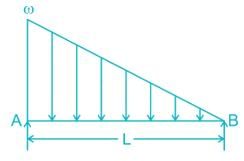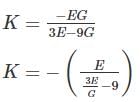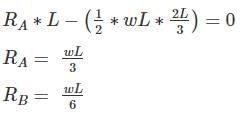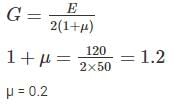Test: Solid Mechanics- 2 - SSC JE MCQ
20 Questions MCQ Test - Test: Solid Mechanics- 2
The maximum deflection due to a uniformly distributed load w/unit length over entire span of a cantilever of length L and of flexural rigidity EI, is
The equivalent length of a column of length L having one end fixed and the other end free is
| 1 Crore+ students have signed up on EduRev. Have you? Download the App |
Two bars of different materials are of the same size and are subjected to same tensile forces. If the bars have unit elongations in the ratio of 3 : 8, then the ratio of moduli of elasticity of the two materials is:
The radius of Mohr’s circle for two equal and unlike principal stresses of magnitude “p” is:
The correct relation between Modulus of elasticity (E), Shear Modulus (G) and Bulk modulus (K) is:
A simply supported beam with a gradually varying load from zero at B and w per unit length at A is shown in figure below, the shear force at B is equal to:

When the shear force diagram is a parabolic curve between two points, it indicates that there is a
The ratio of moment of inertia of circular plate to that of square plate of equal depth is:
A circular shaft of 50 mm diameter is required to transmit a torque from one shaft to another. If shear stress is not to exceed 40 Mpa, the safe torque is:
If a shaft turns at 150 rpm under a torque of 1500 Nm, then power transmitted is
If a close coiled helical spring absorbs 30 N-mm of energy while extending by 5mm, its stiffness will be ______.
A steel bar of 5mm is heated from 5°C to 40°C and is free to expand. The bar will induce
A bar of uniform thickness t and Length L tapers uniformly from a width of b1 at one end to b2 at the other end. What will be the extension of the bar under an axial pull P?
The number of elastic constants for a completely anisotropic elastic material which follows Hooke’s law is
The Poisson’s ratio of a material which has Young’s modulus of 120 GPa, and shear modulus of 50 GPa, is
The change in the slope between two points in a straight member under flexure is equal to the area of M/EI diagram between those two points. This statement is known as -
A simply supported beam is of rectangular section. It carries a uniformly distributed load over the whole span. The deflection at the centre is “y”. If the depth of the beam is doubled, the deflection at centre will be:
The ratio of the moment of resistance of a solid circular shaft of diameter D and a hollow shaft (external diameter D and internal diameter d) is given by























 will be very small and negligible as compared to
will be very small and negligible as compared to  so
so 
 will be large as compared to
will be large as compared to 
 can be neglected. So
can be neglected. So















